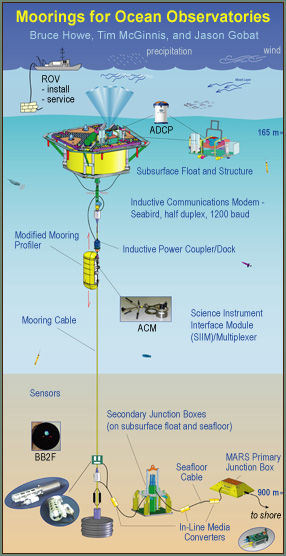 |

|
The ALOHA/MARS mooring sensor network combines adaptive sampling methods with a moored deep-ocean sensor network.
|
|
 |
This project will demonstrate the scientific potential of combining adaptive sampling methods with a moored deep-ocean sensor network at the MARS Observatory. We will directly address the challenge of sampling the ocean with both high temporal resolution and high vertical resolution. With the moored sensor network consisting of a profiler moving between near-surface and abyssal fixed sensors under program control, we will be able to focus the sampling and measurement capabilities on the scientific features of most interest.
The long term goal is to deploy similar moorings at the Aloha Cabled Observatory and the Hawaii Ocean Time-Series (HOT) station, north of Oahu, and on the cabled nodes of the Ocean Observatories Initiative (OOI) of the Ocean Research Interactive Observatory Networks (ORION). This project is funded by the National Science Foundation (NSF) and managed by NSF and the Joint Oceanographic Institutions (JOI).
Scientific features of interest include intense sub-mesoscale eddies, cold bottom water overflow events, tidal mixing, and yet-unknown processes, as well as the long-term background sampling that has been the basis of HOT for the last 14 years. We will develop the optimization software tools that will maximize overall information return given the constraints of competing scientific objectives, the continually changing environment that we are observing, and the physical limitations of our observing sensors and network. The power and two-way real-time communications capability provided by the NSF-funded cabled observatories is a sine qua non without which the sampling improvements and the sensor network, and the resulting science, would not be possible.
Subsequent deployments of similar moored sensor networks are envisioned at the Aloha, Mars, ORION cabled nodes (formerly called Neptune) Hawaii-2 Observatory (H2O) in the mid-Pacific, and on the planned Regional Scale Nodes cabled ocean observatory on the Juan de Fuca Plate. The project will be a contribution to the National Science Foundation (NSF) Ocean Observatories Initiative and the U.S. Integrated Ocean Observing System (IOOS), helping to develop new technology and methods, building toward the vision of a global system of sustained ocean observation.
|






